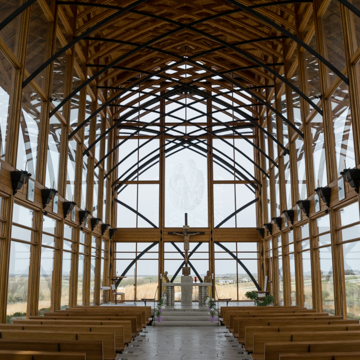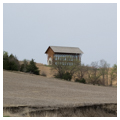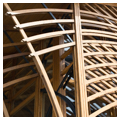Travelers looking southeast along I-80 between Omaha and Lincoln will notice a tall, narrow structure standing resolutely upon bluffs that follow the interstate. The Holy Family Shrine, designed by Jim Dennell of Omaha-based Caiccio Dennell Group (now BCDM architects), is dedicated to drivers and others seeking a place of rest and meditation. But the site has not always been as peaceful as it is today: before the shrine was completed a severe windstorm destroyed the structure, requiring workers to rebuild it from scratch.
Approaching the parking lot from a gravel road, much of the Shrine is at first hidden from view, revealing itself only gradually to visitors through sequential exposures and experiences that are intended to be symbolic of the Catholic faith. One enters the shrine through an underground visitor center, built like a prairie dugout embedded in a bluff. Containing an information area, gathering spaces, a gift shop, and restrooms, the visitor center is also meant as an evocation of Christ’s tomb. Illuminating the limestone-clad interior, a central skylight supports a spiraling stainless-steel sculpture symbolizing Christ’s shroud. Water trickles down the sculpture and drips into a reflecting pool creating a ripple. The water flows through a channel in the floor that leads visitors towards a doorway and a garden with seating areas under a pergola.
Visitors move along the small garden path and water channel on axis with the free-standing chapel that is reminiscent of E. Fay Jones’ Thorncrown in Eureka Springs, Arkansas. A lecture Jones gave in Lincoln in 1993 is said to have inspired the architect to build the shrine. The chapel’s delicate wood structure features arched trusses nearly fifty feet high that interlace in a tracery-like way that also resembles wheat, symbolic of the Eucharist, waving in a field. The design of the spliced arches is so complex that the contractor was given printed full-scale templates to guide construction.
As visitors pass through wooden double doors into the chapel, the water channel splits to each side of the center aisle. Limestone bridges allow those entering the pews to recall their baptism. The streams of water flow together into the pool beneath the altar at the north end of the chapel. The chapel’s glass facades offer uninterrupted views of its secluded surroundings and the Platte River Valley beyond. Outside of the chapel, on a bluff beyond the altar, a forty-foot tall crucifix towers over the native bluestem prairie, its height symbolizing the forty days of Lent. Hanging on the crucifix is an eight-foot tall bronze figure of Christ. The chapel is open to visitors all days of the week.
References
“The Holy Family Shrine.” Accessed June 10, 2014. http://www.holyfamilyshrine.org.





















